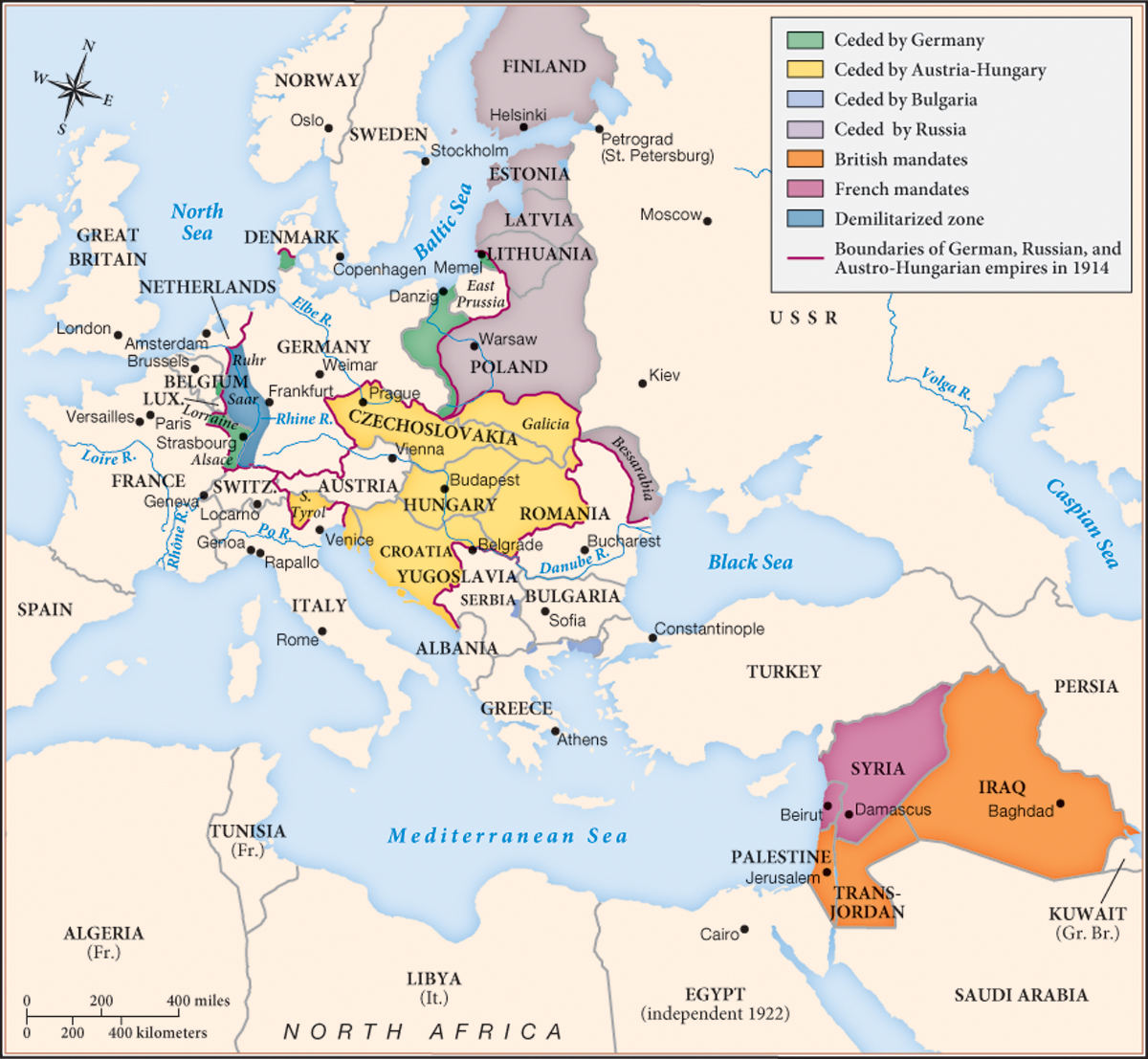The Paris Peace Conference, 1919–1920
Printed Page 836
Important EventsThe Paris Peace Conference, 1919–1920
As political turmoil engulfed peoples from Berlin to Moscow, the Paris Peace Conference opened in January 1919. Visions of communism spreading westward haunted the deliberations, but the assembled statesmen were also focused on the status of Germany and the reconstruction of a secure Europe. Leaders such as French premier Georges Clemenceau had to satisfy angry citizens: France had lost 1.3 million people—almost an entire generation of young men—and more than a million buildings, six thousand bridges, and thousands of miles of railroad lines and roads. Great Britain’s representative, Prime Minister David Lloyd George, caught the mood of the British public by campaigning in 1918 with such slogans as “Hang the kaiser.” The Italians arrived on the scene demanding the territory promised to them in the 1915 Treaty of London. Meanwhile, U.S. president Woodrow Wilson, head of the new world power that had helped achieve the Allied victory, had his own agenda. His Fourteen Points, on which the truce had been based, were steeped in the language of freedom and called for open diplomacy, arms reduction, and the right of nationality groups to determine their own government.
The Fourteen Points did not represent the mood of all the victors. Allied propaganda had made the Germans seem like inhuman monsters, and some military experts feared that Germany was using the armistice only to regroup for more warfare. Indeed, Germans widely refused to admit that their army had lost the war. Eager for army support, Ebert had given returning soldiers a rousing welcome: “As you return unconquered from the field of battle, I salute you.” Wilson’s plan, based on settlement as opposed to surrender, however, recognized that Germany was still the strongest state on the continent. Economists and other specialists agreed that, harshly dealt with and humiliated, Germany might soon become vengeful and chaotic—a lethal combination.
After six months, the statesmen and their teams of experts produced the Peace of Paris (1919–1920), a cluster of individual treaties that shocked the citizens of the countries that had to accept them. The treaties separated Austria from Hungary, reduced Hungary by almost two-thirds of its inhabitants and three-quarters of its territory, broke up the Ottoman Empire, and treated Germany severely. They replaced the Habsburg Empire with a group of small, internally divided, and economically weak states: Czechoslovakia; Poland; and the Kingdom of the Serbs, Croats, and Slovenes (soon renamed Yugoslavia). After a century and a half of partition, Poland was reconstructed from parts of Russia, Germany, and Austria-Hungary—leaving one-third of its population ethnically non-Polish. The statesmen in Paris also created the Polish Corridor, which connected Poland to the Baltic Sea and separated East Prussia from the rest of Germany (Map 25.3). Austria and Hungary were both left reeling at their drastic loss of territory and resources.

The Treaty of Versailles, the centerpiece of the Peace of Paris, specifically dealt with Germany. In it, France recovered Alsace and Lorraine, and the Allies would temporarily occupy the left, or western, bank of the Rhine and the coal-bearing Saar basin. Germany would pay substantial reparations for civilian damage during the war, set in 1921 at the crushing sum of 132 billion gold marks. Germany also had to reduce its army, almost eliminate its navy, stop manufacturing offensive weapons, and deliver a large amount of free coal each year to Belgium and France. Furthermore, it was forbidden to have an air force and had to give up its colonies. Article 231 of the treaty described Germany’s “responsibility” for damage caused “by the aggression of Germany and her allies.” Outraged Germans interpreted this as a war guilt clause, which blamed Germany for the war and allowed the victors to collect reparations from their economically developed country rather than from ruined Austria. War guilt made Germans feel like outcasts in the community of nations.
Besides redrawing the map of Europe, the Peace of Paris set up an organization called the League of Nations, whose members had a joint responsibility for maintaining peace—a principle called collective security. It was supposed to replace the divisive secrecy of prewar power politics and arbitrate its members’ disputes. The U.S. Senate failed to ratify the peace settlement and refused to join the league. Moreover, Germany and Russia initially were excluded from the league and were thus blocked from working cooperatively with it. The absence of these three important powers weakened the league as a global peacekeeper.
The League of Nations also organized the administration of the former colonies and territories of Germany and the Ottoman Empire—such as Togo, Cameroon, Syria, and Palestine—through systems of political control called mandates. (See “Contrasting Views: The Middle East at the End of World War I: Freedom or Subjugation?”) While the victorious powers exercised their mandates, local leaders retained limited authority. The league justified the mandate system as providing governance by “advanced nations” over territories “not yet able to stand by themselves under the strenuous conditions of the modern world.” The mandate system not only kept imperialism alive at a time when the powers were bankrupt and weak but also, like the Peace of Paris, aroused anger and resistance.